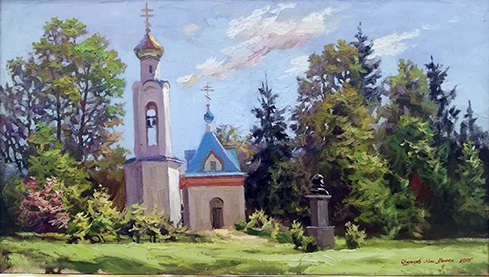
An exhibition themed "Russian Landscape” opened at the Vietnam National Fine Arts Museum in Hanoi on October 10, as part of activities to celebrate the 15th anniversary of the Russian Centre of Science and Culture in Hanoi.
|
A work at the exhibition.
|
|
|
|
The event was attended by delegation of the Vietnam-Russia
Parliamentary Friendship Group; Ministry of Culture, Sports and Tourism;
Russian ambassador to Vietnam Konstantin Vnukov; and Head of the Federal
Agency for the Commonwealth of Independent States Affairs, Compatriots Living
Abroad, and International Humanitarian Cooperation (Rossotrudnichestvo),
Eleanora Mitrofanova.
At the opening ceremony, delegates affirmed that the event is an
opportunity to promote cultural exchanges and to promote the friendship and
cooperation between Vietnam and Russia.
On the same day, under the framework of the series of events,
the Russian Centre of Science and Culture in Hanoi organised the cultural
programme at the Hanoi Opera House by a troupe from the "Gzhel” Moscow National
Academic Theatre of Dance.
The theatre was founded in 1988 to commemorate the 650th
anniversary of the existence and development of one of the most well-known
and most recognisable traditional Russian handicraft creations, Gzhel
ceramics. The theatre is known for having Russia’s most outstanding talented
and creative artists.
|
Source: NDO
With an increasingly vibrant and widespread emulation movement aimed at building cultured residential areas and cultured families, Yen Thuy District has been making steady progress toward improving both the material and spiritual well-being of its people, while fostering a civilized, prosperous, beautiful, and progressive community.
Once lacking recreational spaces and community facilities, Residential Group 2 in Quynh Lam Ward (Hoa Binh City) has recently received attention for the construction of a new, spacious, and fully equipped cultural house. The project followed the model of state support combined with public contributions in both labor and funding.
The "All people unite to build cultural life" movement, which has been effectively integrated with Kim Boi district’s socio-economic development goals, is fostering a lively spirit of emulation across local residential areas, hamlets, villages, public agencies, and enterprises. In addition, through the initiative, traditional cultural values are being preserved and promoted, while community solidarity and mutual support in poverty reduction and economic development are being strengthened.
A working delegation of the Hoa Binh provincial People’s Committee led by its Permanent Vice Chairman Nguyen Van Toan on June 11 inspected the progress of a project to build the Mo Muong Cultural Heritage Conservation Space linked to tourism services in Hop Phong commune, Cao Phong district.
Born and growing in the heroic land of Muong Dong, Dinh Thi Kieu Dung, a resident in Bo town of Kim Boi district, in her childhood was nurtured by the sweet lullabies of her grandmother and mother. These melodies deeply imprinted on her soul, becoming an inseparable part of her love for her ethnic group's culture. For over 20 years, this love for her hometown has driven Dung to research, collect, and pass down the cultural values of the Muong people to future generations.
In the final days of May, the Ethnic Art Troupe of Hoa Binh Province organized performances to serve the people in remote, mountainous, and particularly disadvantaged areas within the province. These were not just ordinary artistic shows, but they were the meaningful journeys aimed at spreading cultural values, enhancing the spiritual life of the people and contributing to the preservation of ethnic minority cultural identities.



